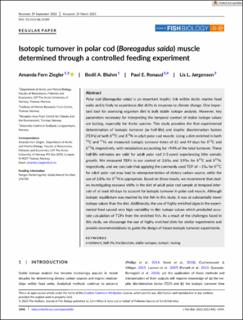| dc.description.abstract | Polar cod (Boreogadus saida) is an important trophic link within Arctic marine food webs and is likely to experience diet shifts in response to climate change. One important tool for assessing organism diet is bulk stable isotope analysis. However, key parameters necessary for interpreting the temporal context of stable isotope values are lacking, especially for Arctic species. This study provides the first experimental determination of isotopic turnover (as half-life) and trophic discrimination factors (TDFs) of both δ13C and δ15N in adult polar cod muscle. Using a diet enriched in both 13C and 15N, we measured isotopic turnover times of 61 and 49 days for δ13C and δ15N, respectively, with metabolism accounting for >94% of the total turnover. These half-life estimates are valid for adult polar cod (>3 years) experiencing little somatic growth. We measured TDFs in our control of 2.6‰ and 3.9‰ for δ13C and δ15N, respectively, and we conclude that applying the commonly used TDF of ~1‰ for δ13C for adult polar cod may lead to misrepresentation of dietary carbon source, while the use of 3.8‰ for δ15N is appropriate. Based on these results, we recommend that studies investigating seasonal shifts in the diet of adult polar cod sample at temporal intervals of at least 60 days to account for isotopic turnover in polar cod muscle. Although isotopic equilibrium was reached by the fish in this study, it was at substantially lower isotope values than the diet. Additionally, the use of highly enriched algae in the experimental feed caused very high variability in diet isotope values which precluded accurate calculation of TDFs from the enriched fish. As a result of the challenges faced in this study, we discourage the use of highly enriched diets for similar experiments and provide recommendations to guide the design of future isotopic turnover experiments. | en_US |
